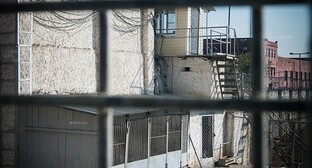16 April 2003, 01:58
Kayaev, Ali
One of Dagestan's major Muslim enlightenment educators and encyclopedic scientists of late 19th - first half of 20th centuries.
Born in 1878 in the village of Kumukh (alternatively, Gazi-Gumuk) of Lak area of Dagestan in a family of a free commoner (uzden), gun maker by profession. At the age of 7, lost his father who was killed by robbers in the village Zakataly. Ali Kayaev's mother was forcibly married by her relatives into another village. The boy was raised in the house of Nazhavat, his paternal aunt.
In 1880-90, received good Muslim education in madrasah schools of Highland Dagestan. Studied Arabic grammar, rhetoric, logic, tafsir, khadises, law (fikkh of Shafiit interpretation), as well as basics of mathematics, astronomy, and other secular sciences. His teacher was at first Gazi, son of sayid-Husayn al-Gazi-Gumuki, and later famous Dagestani mudarrises Khalil al-Karakhi, Djabra il-effendi al-Khotodi, Mirza-kadi al-Balkhari, Murtada-Ali al-Kudali, and sheikh Ali As-Suguri (of Sogratl settlement). In 1899, Ali Kayaev copied the Arabic chronicles Glow of Dagestani Sabers in a Number of Shamil's Battles by Muhammad-Takhir al-Karakhi for mudarris Abd ar-Rakhman, son of Abd al-Vahhab. Later, it serves as a base for publishing this manuscript by A.M. Barabanov under I.Y. Krachkovsky's editorship in 1946. In 1900-1905, worked as a teacher in a madrasah in Astrakhan under the invitation of Abd ar-Rakhman.
In 1905, moved to Cairo and continued his education in University al-Azkhar until 1907. Still in Dagestan, Ali Kayaev got acquainted with the works of Jamal ad-din al-Afghani, Muhammad Abdo, and Rashid Rida, the ideologists of reformatory branch of Islam (al-jadidiya), and was drawn by their ideas. According to unconfirmed information, Ali Kayaev, while in Cairo, was employed at Al-Manar magazine, in which Rashid Rida was an editor. In 1908, he moved to Istanbul, intended to continue his scientific work there, but was arrested and deported to Russia for his radical views.
Upon returning home, he opened a madrasah in 1908 in a village of Gundelen, Kuban region (now Karachayevo-Cherkessia) where for the first time in the Caucasus the system of Muslim education was reformed and re-orientated to studying law (al-fikkh), history, and a course of secular sciences (mathematics, astronomy, and natural sciences). In 1913, Ali Kayaev moved to the center of Dagestani Region, the city of Temir-Khan-Shura (now Buynaksk), where he opened a madrasah and worked in it until 1918. Well-known representatives of early-20th-century liberal democratic Dagestani intelligentsia studied with Ali Kayaev: M. Aliev, G. Gitinaev, K. Zakuev, I-H. Kurbanaliev, G. Saidov, M.-D. Shamkhalov, and others. His follower was M.-S. Saidov, a great Dagestani scientist of soviet time. When a civil war burst out in Dagestan in March 1918, Ali Kayaev moved to Kumukh together with his family, where he administered the area's largest madrasah of the Cathedral Mosque in 1918-1928; about 300 students attended the madrasah. Here, he continued the instruction reform widening the circle of taught disciplines considerably. Chemistry, physics, algebra, geometry, geography, natural sciences, astronomy, native history, and Lak language were introduced. By the level of education delivered, his school was equal to Muslim universities of early 20th century in Russia and abroad.
Ali Kayaev's temper was not that of a bench scientist. He was vividly interested in sociopolitical life in the world, Russia, and North Caucasus. Having a bright journalist's talent, he cooperated with Muslim periodicals of liberal democratic branch. From 1913 to March 1918, he edited the Djaridat Dagestan newspaper, published in Arabic in Temir-Khan-Shura by B. Saidov's Society of Enlightenment of Local Muslims. In his time, it became the voice of Muslim enlightenment and jadidism. Also collaborated with newspapers Ilchi (Messenger) and Channa tsuku (Star) published in 1917-1918 in Lak language. Ali Kayaev welcomed the 1917 February Revolution seeing the start for Caucasian peoples' liberation from czarist colonial regime in it. Thanks to his popularity in democratically minding Muslim circles, was elected into Dagestani regional Council and into its Executive Committee in January 1918. However, as soon as in March 1918 resigned from the government when the power in the Region was overtaken by an ultra-right wing of the Muslim Party headed by Ali Kayaev's personal enemy sheikh Nadjm ad-din of Gotsob settlement (more known as Nadjmuddin Gotsinsky).
After the Caucasus survived first "white" and then "red" terror, Ali Kayaev became disillusioned about the Revolution. In spring 1918, he stopped taking part in Dagestan's social life. He spent most of his time in Kumukh, occupying himself with teaching, scientific research, and writing. Besides, in 1918-1925, Ali Kayaev served as a chairman (kadi) of Shari'ah court of Kumukh. In 1928, at an invitation from the government of Dagestan composed of Ali Kayaev's former students and acquaintances, he moved to Makhatchkala, receiving a position in the republican Museum of Local Studies. In 1928-1930, traveled a lot in highland areas of Dagestani ASSR (Autonomous Soviet Socialist Republic) collecting materials on history and ethnography of the highlanders.
Stalin's repressions descending upon Ali Kayaev's benefactors could not bypass him as well. He was first arrested by NKVD in 1930 on the charge of "counter-revolutionary activities" and exiled to South Urals for five years. In 1934, he was freed ahead of time by a request from J. Kormasov, chairman of People's Commissar Council of Dagestani ASSR, and Y. Shovkrinsky, secretary of Dagestani Executive Committee of VKP(b) for ideology, who both knew Ali Kayaev closely. The same year, Ali Kayaev became an employee of Dagestan Scientific Institute in Makhatchkala. Over those years, he continued collecting materials on pre-Revolution history of Dagestan, translated extensively from Arabic, Persian, and Turkish, traveled to settlements in highland Dagestan, and worked with Scientific Institutes of Tbilisi and Moscow. In 1938, the second arrested followed. He was charged with connections with "an enemy of the nation" J. Kormasov and with espionage for Turkey. In February 1940, was exiled to Kazakhstan for 5 years at a verdict by OSO of USSR's NKVD. While in exile, worked as a gate-keeper at a bathhouse. In 1943, Ali Kayaev contracted typhus and deceased on December 21 in the city of Georgievka, Semipalatinsk Region. Was buried in the local Russian cemetery. The location of Ali Kayaev's grave is unknown. In mid-1960s, as many others repressed illegitimately, Ali Kayaev was rehabilitated posthumously.
Ali Kayaev left an immense literary and scientific legacy in Arabic, Turkish, and Lak languages. It still remains uncollected and unstudied completely. Only passages are published of his work written during the soviet power. Some of them were translated into Russian by his son Abd al-Madjid (or Abdulmedjid, d. 1989). Much has been missing since Ali Kayaev's arrests. In 1938 only, the NKVD officials expropriated 7 voluminous folders with manuscripts. To discover them in KGB archives has been impossible. His first works were published in M. Mavraev's publishing house in early 1910s. They are textbooks on Dagestan's history al-Khikayat al-madiya bi-lisan Gazi-Gumuk (The Stories of the Past in Lak Language) and astronomy ar-Risala fi-l-hay'a al-jadida bi-lisan Gazi-Gumuk (Treatise on New Astronomy in Lak Language). In 1913-1930, Ali Kayaev wrote a number of works on natural sciences, lexicography (lugat), khadis studies, history and literature of Dagestani peoples, dozens of small articles on natural sciences, humanities, and pedagogy. The major among them are Physical Geography (date unknown, in Lak), An Arrow Piercing an Infidel's Throat (in Arabic, early 1920s), and written at Dagestani government's order ash-Sharia al-islamiya (1926 - ?) and History of the Civil War (in Lak, 1924-1935). Ali Kayaev's major works in Arabic and Lak in 1930-1943 are Materials on Dagestan's History, Tarikat in Dagestan, Materials on Dagestan's Language and History, Explanatory Dictionary of Lak Language, and Comparative Dictionary of Lak, Dargin, and Avar Languages (unfinished). At the same period, Biographies of Dagestani Scientists (in Turkish) were compiled. His last work, Materials on the Language and History of the Lak, was finished in 1942 while in exile and handed over to Nadjm ad-din, his son. This and the major part of Ali Kayaev's other manuscripts are now stored in his grandson Ilyas's (son of Abd al-Madjid Kayaev) private archive in Buynaksk. Ali Kayaev's works are also kept in Manuscript Fund of History, Archeology, and Ethnography in Makhatchkala.
Ali Kayaev's major compositions' published, besides the aforementioned:
- On Libraries in Dagestan // Manuscript and Printed Book in Dagestan. Makhatchkala, 1991, pp. 48-51.
- ?Nadir-shah's Defeat in Dagestan // Our Dagestan. Makhatchkala, 1992, p. 161.
- ?The Khazars // ibidem, 1994, pp. 167-168.
- Two Different Orientations // ibidem, 1994, pp. 169-170.




